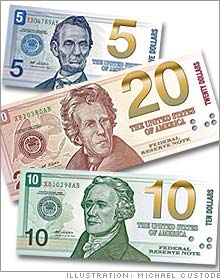New U.S. bills: blind justice?A judge ruled in favor of altering U.S. currency to assist the blind, but blind advocacy groups are not cheering the decision. Fortune's Roger Parloff reports.(Fortune Magazine) -- In late November, when a federal district judge ruled that American greenbacks violate the federal Rehabilitation Act because the various denominations are not readily distinguishable by blind people, the American Council of the Blind scored a stunning victory. Since 1983, the advocacy group has been urging U.S. Treasury officials to make paper money easier for the blind to use. Blind people typically determine the denominations of paper money by using bill-reading machines or by asking sighted people a bill's value and then folding the various denominations in different ways.  In 2002 the ACB finally sued, and on Nov. 28 Judge James Robertson of Washington, D.C., ruled that if blind people "cannot accurately identify paper money without assistance" they are being illegally denied "meaningful access" to the currency in violation of the law. It might have seemed like an occasion for celebration by all blind Americans, but instead the decision illuminated a major philosophical division within the visually impaired community. Shortly afterward, the National Federation of the Blind (NFB) - an advocacy group with an agenda distinct from that of the American Council of the Blind - denounced the judge's ruling as "dangerously misguided" and pledged to support the Treasury's appeal of it. The NFB's president, Dr. Marc Maurer, issued a statement arguing that "blind people transact business with paper money every day" and don't need "feel-good gimmicks that misinform the public about our capabilities." The NFB's fear is that special treatment may hurt the chances of blind people being taken seriously by businesses. "An employer who believes that every piece of printed material in the workplace must be specially designed so that the blind can read it will have a strong incentive not to hire a blind person," adds Maurer. Headquartered at the National Center for the Blind in Baltimore, the NFB maintains that it is the oldest and largest organization of blind persons in America, with 50,000 members. (The Las Vegas-based ACB claims about 40,000.) Paper currency isn't the only flashpoint. The NFB also opposes the ACB's initiative to get legislation passed that would require adoption of "video description" technologies that give blind viewers the option of hearing voice-overs explaining the visuals on TV and movies. Says NFB spokesperson John Paré: "Our focus is on education and working, not sitting at home and watching TV." The ACB spokesman, Day Al-Mohamed, counters that video descriptions provide access to emergency messages that are often delivered via crawls at the bottom of the TV screen. The rift cannot be reduced to enablers vs. tough-lovers, for the NFB will litigate when it believes accessibility is being denied to something more essential. Last March it sued Target (Charts) for allegedly failing to make its Web site accessible to the blind. The NFB won an important preliminary ruling in the Target case in September, when U.S. District Judge Marilyn Hall Patel of San Francisco rejected Target's contention that the Americans With Disabilities Act - which forbids discrimination at "any place of public accommodation" - applies only to physical facilities. A Target spokesperson declined an interview, but referred Fortune to a statement it issued in October: "We are in the process of making online enhancements that will benefit all of our guests, including those with disabilities. These enhancements will occur regardless of the outcome of this lawsuit." There's no question that changing the U.S. currency would cost more than fixing a Web site. The most expensive option - adopting different-sized bills for different denominations - would require an initial investment of about $215 million to $228 million for new presses and plates, according to the Treasury. But against the background of a $4.2 billion budget over the past ten years (encompassing major currency redesigns in 1996 and 2004), Judge Robertson ruled that such costs would not constitute an undue burden. He also observed that of the 180 nations using paper currency today, the U.S. is the only one currently taking no steps to make denominations legible to the blind. |
|
